Planting Crops in Your Garden
Choosing which crops to plant in your garden can be a lot of fun – and maybe a little daunting. Below, a list of options for spring, summer and winter gardening in Chicago, plus planting and harvesting tips.
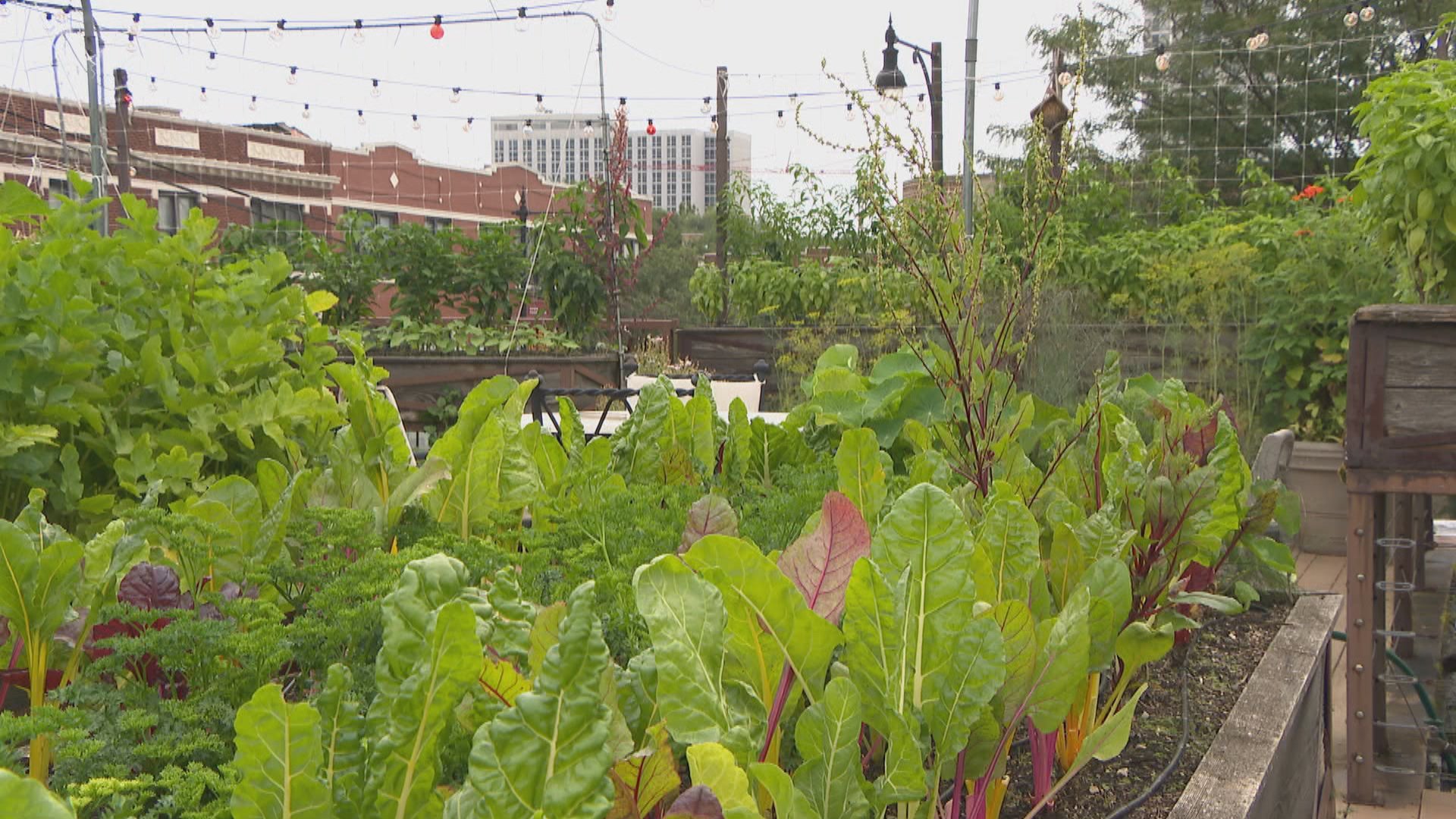
Spring Crops
Skip to: Arugula | Beets | Beets – Chioggia | Beets – Golden | Broccoli | Brussels Sprouts | Bulb Fennel | Carrots | Carrots – Paris Market | Cauliflower – Purple | Cauliflower – Romanesco | Collard Greens | Edamame | Hakurei Turnip | Kale – Green Curly | Kale – Red Russian | Kale – Tuscan/Dinosaur | Kohlrabi | Leeks | Lettuce – Dark Red Lollo Rosso | Lettuce – Deer Tongue | Lettuce – Green Oakleaf | Lettuce – Head | Lettuce – Little Gem | Lettuce – Romaine | Lettuce Mix | Radish | Radish – Easter Egg | Radish – French Breakfast | Red Cabbage | Red Onion | Scallion | Spicy Greens Mix | Spinach | Sugar Snap Peas | Swiss Chard
Summer Crops
Skip to: Basil | Black Cherry Tomato | Carmen Red Pepper | Cayenne Hot Pepper | Cilantro | Cucumber | Dancer Eggplant | Dandelion | Dill | Fish Pepper | Garlic Chives | Gem Marigold | Gold Berry Tomato | Green Tomatillo | Green Zebra Tomato | Habanero/Serrano Pepper | Haricot Vert | Italian Parsley | Italian Pole Bean | Jalapeño | Japanese Eggplant | Lemon Basil | Lemon Cucumber | Lemon Verbena | Lime Basil | Malabar Spinach | Marigold | Mexican Sour Gherkin | Nasturtium | Orange Lunchbox Sweet Pepper | Oregano | Persian Cucumber | Pink Bumble Bee Tomato | Purple Basil | Purple Bumblebee Tomato | Purslane | Red Cherry Tomato | Red Okra | Red Yard Long Bean | Rosemary | Salt and Pepper Cucumber | Shishito Hot Pepper | Silver Queen Corn | Silver Queen Okra | Sorrel | Sunflower | Sungold Tomato | Suyo Long Cucumber | Sweet Alyssum | Sweet Bell Pepper | Thai Sweet Basil | Thyme | Tri-Color Bush Beans | Turkish Orange Eggplant | White-Skinned Cucumbers | Yellow Wax Bean | Zucchini
Season Extension and Winter Crops
Skip to: Arugula | Chard (Bright Lights) | Garlic | Kale Vates (Green Curly) | Lettuce (Cold Mix) | Spinach | Tatsoi
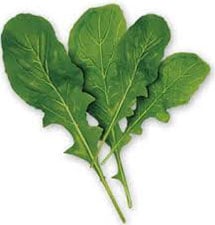
Arugula
When to Plant
March 15-May 30 or Aug. 15-Sept. 15. Arugula can be planted up to three weeks before the first frost (generally Oct. 15).
How to Plant
Plant from seed. Plant an abundance of seeds (you want to overplant), and cover the seeds with about 1/4 to 1/2 inch of soil.
Harvesting Tips
Arugula will germinate quickly, and they need to be eaten quickly before they develop a seed stalk and get bitter and tough. Begin harvesting arugula at baby green size (2.5-3 inches). Cut it and leave about 1.5 inches of growth, let the plant grow back to 2.5-3 inches, cut again and remove entire plant. Eat when young. The bigger arugula gets, the spicier it gets.
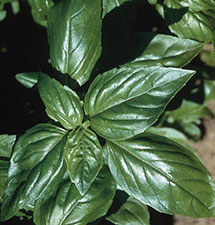
Basil (Traditional)
When to Plant
May 15-July 30
How to Plant
Transplant seedling or direct seeding.
Harvesting Tips
Begin harvesting as soon as the plant is large enough to spare some leaves. At any sign of flowering, pinch off the flower unless you have so much that you’re intentionally letting it flower. Once basil flowers, it spends more energy on the flowers than the leaves. At that point, the leaves can become bitter and tougher, and not as pleasant for pesto and fresh eating. Cut the flower with a pruner at a point along the stem just above a fresh set of leaves. If done correctly, it still looks busy and full.
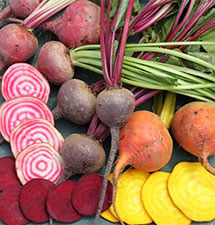
Beets (Red)
When to Plant
March 15-May 30 or July 15-Aug. 1
How to Plant
Plant from seed. Direct seeds about 1/2 inch deep about 1 inch apart.
Harvesting Tips
Beets planted March to May will be ready early summer to mid-summer. Beets planted July to August will be ready for mid to late fall harvest. Thin beets so they are a fist’s width apart. Do not thin as soon as they emerge. Wait until greens are 1/2 inch–1 inch tall. After thinning, mound the soil and firm it around each plant. Beet thinnings can be consumed. If you see the top of the beets come above the ground, cover them with earth. Harvest is approximately 60 days from planting. Around the 60th day, pull one of the beets and see if it is about 1.5 inches in diameter. If so, begin harvesting. If you would like bigger beets, wait.
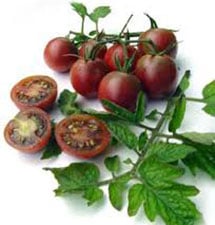
Black Cherry Tomato
When to Plant
May 15-July 15
How to Plant
Transplant seedling.
Harvesting Tips
Keep an eye on them. If pests such as squirrels or chipmunks are munching on them, harvest on the early side of ripe and place tomatoes in a window sill to finish ripening. Judge ripeness by color and touch. Is the tomato the color it’s supposed to be? When you gently press into the skin, does it give a little and feel somewhat soft? Keep pruning to a minimum if at all as this can spread disease. If fruit is ripening slowly, remove excess foliage to expose the fruit to more sunlight.
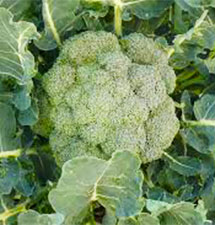
Broccoli
When to Plant
March 15-Aug. 31
How to Plant
Transplant seedling.
Harvesting Tips
Broccoli is ready when a firm, tight head is formed. The broccoli head typically will get to be 4-7 inches wide when it is time to harvest. But do not go on size alone. If florets are not tightly packed and begin to separate, then you should harvest immediately or the florets with bolt and become bitter. When the florets on the outside edge of the head get to be the size of the head of a match, then you can start harvesting broccoli from that plant. Use a sharp knife or pruners to cut the head of the broccoli off the plant. You should cut the broccoli stem a few inches or more below the head. After you have harvested the main head, you can continue to harvest the side shoots from the broccoli. These will grow tiny heads to the side of where the main head was. Harvest the in the same fashion as the broccoli head.
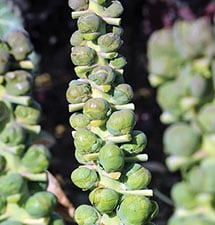
Brussels Sprouts
When to Plant
April 15-June 15. In our area, plant Brussels sprouts by June 15 to make sure there is enough time for the buds to develop. Brussels sprouts benefit from a late harvest; they become sweeter once they have experienced a light frost.
How to Plant
Transplant seedling.
Harvesting Tips
Brussels sprouts are very cold tolerant. Harvest when they are slightly smaller than a golf ball. They can be harvested around Thanksgiving or shortly thereafter; taste often improves after a frost.
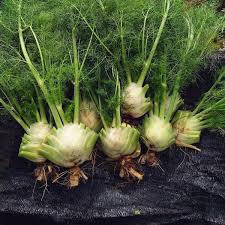
Bulb Fennel
When to Plant
Early- to mid-May.
How to Plant
Start bulb fennel seeds indoors in early spring, about 8 weeks before your last frost, and set them out under cloches when they have one true leaf. When growing fennel, prepare a fertile, well-drained bed in a spot that is convenient to water, because bulb fennel must have moist soil. Once the bulb begins to form at the base of the stem, hill up the surrounding soil to cover it. This shades it from the sun and prevents it from turning green. This is known as blanching, as it keeps the bulb white and sweet (which is only necessary if you intend to eat the bulb).
Harvesting Tips
Florence fennel bulbs can be harvested once they reach the size of a small tennis ball, usually in late summer/early autumn. To harvest, cut the fennel below the bulb at the soil line. Use immediately, or store in the refrigerator for several days. Fennel bulbs will survive a frost or two, so no need to harvest them as soon as the weather turns cold. However, you shouldn't allow the fennel bulb to grow too large, or it will turn bitter.
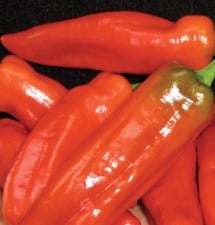
Carmen Red Pepper
When to Plant
May 15-July 15
How to Plant
Transplant seedling.
Harvesting Tips
These peppers are sweet from the start, and they will be sweetest when harvested at their deepest red color. Simply pick by hand when ready. The Carmen is an Italian variety, and works best roasted or fried. This pepper is very adaptable and disease resistant, and a fine candidate for containers or indoor planting.
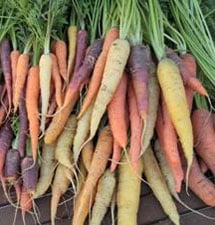
Carrots (Rainbow)
When to Plant
March 15-July 15. If you want a carrot crop that is ready before winter sets in, your last chance for seeding is July 15. After that date, any carrots you plant will need to be covered with fabric (such as a spun polymer fabric) or straw-mulched, and harvested early winter.
How to Plant
Plant from seed. Direct seeds about 1/2 inch deep about 1 inch apart.
Harvesting Tips
Carrots take 65-75 days to mature, depending on the time of year and weather conditions. When the tops of the carrots are 2 inches high, thin the carrots, leaving 2-3 fingers’ width (approximately 1.5-2 inches) between each plant. Carrots are sweetest when harvested in cold weather. Time your planting so the harvest occurs in fall or early winter. For carrots that have 90 days to maturity, plant in early July to harvest in October.
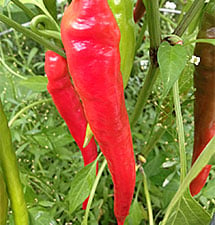
Cayenne Hot Pepper
When to Plant
May 15-July 15
How to Plant
Plant seedlings purchased from a nursery or started from seed indoors 8 weeks before the average last frost (usually May 15 in Chicago). Plant after the danger of frost has passed (usually after Memorial Day in Chicago). Make a planting hole twice as large as the container the seedling is in, remove seedling from pot, open the roots with your fingers, and place in the planting hole. Plant deeply, up to the first set of leaves, and tuck the soil back around the plant stem. Water the root area well, and keep moist during the first 5-10 days after transplanting.
Harvesting Tips
The cayenne pepper is a long, thin, classic hot pepper. While these peppers are mildly hot, they are still slightly sweet. Best harvested when bright red, simply snip the stem from the plant.
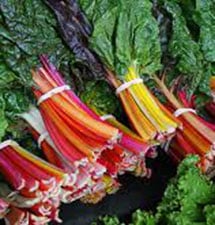
Chard (Bright Lights)
When to Plant
For an early spring harvest, continuing into summer, seed chard by Sept. 20.
How to Plant
Plant from seed. Direct seed about 1 inch deep, about 6-8 inches apart.
Harvesting Tips
Swiss chard seeded as a season extension crop can be harvested as a baby lettuce green in late fall (harvest outer leaves only if you want to have chard grow into spring). Just like kale, harvest just the outer leaves and limit harvest to 3-4 leaves at a time. Do not take all leaves off at once, and make sure to leave the tender center leaves to grow into larger leaves.
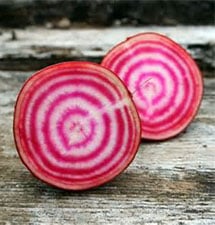
Chioggia Beets
When to Plant
March 15-May 30 or July 15-August 31
How to Plant
Plant from seed.
Harvesting Tips
Apart from the root of the beets, the leaves can also be used similarly to chard – eat raw, cooked, or juiced. Harvesting beets depends on the size you prefer to consume. Beets start to become harvestable when their tops protrude above the soil. The best beets tend to be darker in color with smooth skin. If you wait too long, they can become fibrous or soft and squishy.
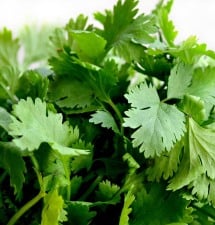
Cilantro
When to Plant
May 15-July 15
How to Plant
Plant from direct seed.
Harvesting Tips
A classic herb with fresh, bright flavor. It’s a staple in fresh salsa, pico de gallo and guacamole. Cilantro likes cool weather and will grow fast in the early months. Harvest the green leaves and avoid cutting away more than one third of the plant. Later in the season, the plant will develop flowery stalks. When these seeds dry and turn brown, you can harvest them as coriander. Clip the round seed heads, place upside down in a paper bag, and in a few days the husks will split, dropping the edible seed. You can plant repeatedly throughout the season to get a continual harvest. This is a great candidate for container growing.
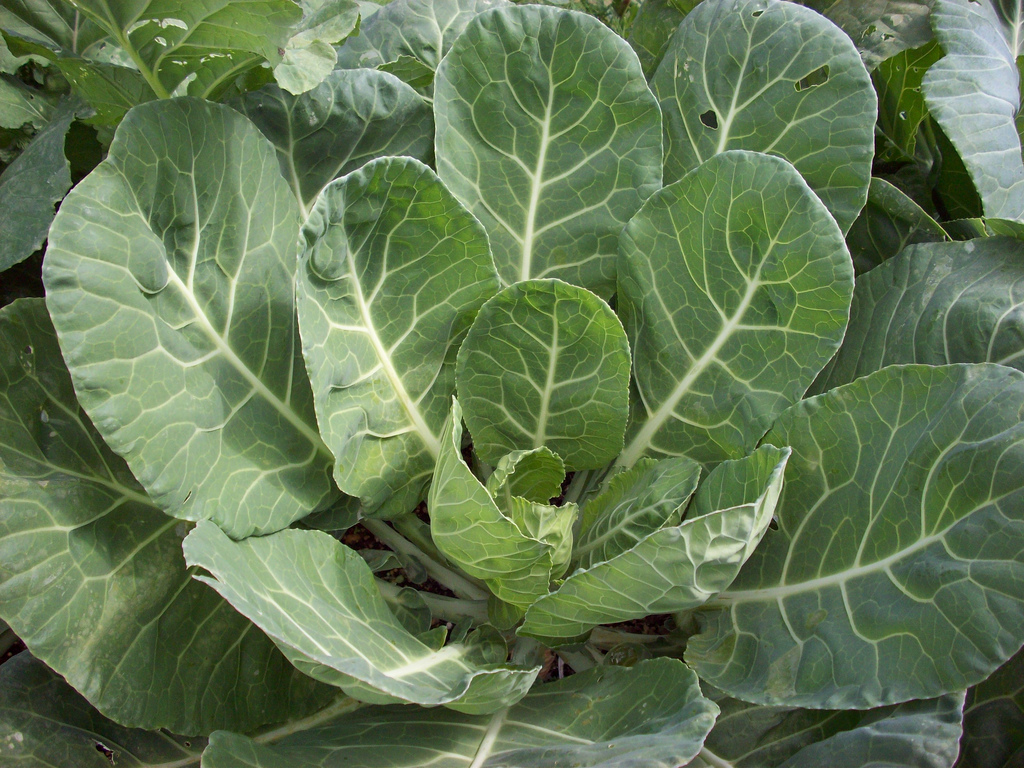
Collard Greens
When to Plant
March 15-Aug. 1
How to Plant
Plant from seed or transplant seedling.
Harvesting Tips
Thin aggressively - you will be rewarded! Ultimately, get the plants thinned to 8-12 inches apart. Harvest the leaves from the bottom up and tidy the plant as you go. Remove and discard of any old, yellowed leaves at the base. Cut the leaves at the base. Do not take all of the leaves off at once. This ensures that the plant will continue to regenerate. Collard greens are great both raw and cooked - often sautéed with onion. We also recommend that you eat the thinnings as you go.
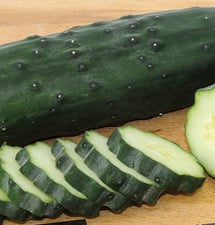
Cucumber
When to Plant
May 15-July 15
How to Plant
Plant from seed or transplant seedling.
Harvesting Tips
Thin the plant and leave the healthiest, largest seedling in the ground (usually 3 to 4 seeds are planted to start if using direct seed). Cucumbers like to climb - attach them to a fence, trellis, or cage with loose ties. The fruit is well camouflaged - look closely as it can hide from you! Once you harvest your first cucumber, look for new fruit daily. Don’t wait too long - delicious when young.
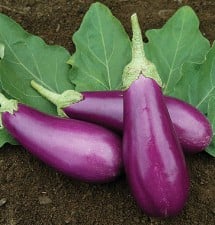
Dancer Eggplant
When to Plant
May 15-July 15
How to Plant
Transplant seedling.
Harvesting Tips
A deep pink Italian variety, mild and not bitter with a classic shape. Harvest 60 to 80 days from when you put the plant in the ground. Use a knife or pruners to cut the stem during harvest. Harvest as soon as the fruit seems ready, and avoid letting it touch the ground so that bugs and critters don’t get to it.
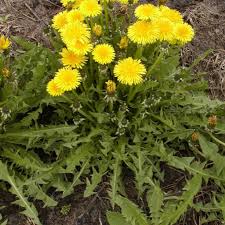
Dandelion
When to Plant
Mid to late spring.
How to Plant
Sow your dandelion seeds 1/4 to 1/2 inch deep in your seedbed in mid- to late spring, spacing the seeds 2 to 3 inches apart. Dandelion seeds require a great deal of light germinate, so do not cover the seeds with soil. Water your dandelion seeds lightly, keeping the top inch of soil moist but not wet. Dandelions grow quickly when well-watered, so it is best to control the amount of water your dandelions get so they don't grow out of control.
Harvesting Tips
Harvest your dandelion in the late summer or fall by cutting the leaves off just below the crown with a sharp knife. The leaves should be harvested when they are less than 10 inches long before the plant flowers, or they will become bitter in taste. Dig up your dandelion plants using a needle-nose spade if you plan to harvest the roots. The roots are best harvested in the fall of the first year or early spring of the second year.
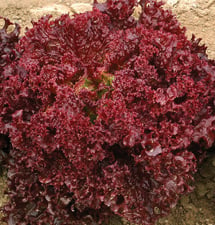
Dark Red Lollo Rosso Lettuce
When to Plant
March 15-Aug. 31
How to Plant
Plant from seed or transplant seedling.
Harvesting Tips
If started from seedling, it’s ready in 2-3 weeks; if started from seed, it’s ready in 30-45 days. There are two ways to approach harvest: If growing for a head of lettuce, thin 8 inches apart, eat outer leaves until it’s getting vertical height then pull it out. Or use the “cut and come again” method. Do not thin. Cut with scissors. Harvesting can begin when lettuce is 3-4 inches tall. Once it starts to taste bitter, pull it out. If harvesting lettuce when hot, “hydrocool” it – let lettuce sit in a sink full of cold water for 5-10 minutes, then spin in salad spinner and eat, or store in well sealed storage container or Ziploc bag (air-tight storage is key).
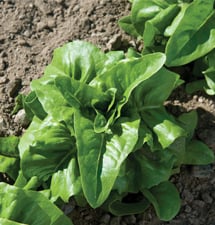
Deer Tongue Lettuce
When to Plant
March 15-Aug. 31
How to Plant
Plant from seed or transplant seedling.
Harvesting Tips
If started from seedling, it’s ready in 2-3 weeks; if started from seed, it’s ready in 30-45 days. There are two ways to approach harvest: If growing for a head of lettuce, thin 8 inches apart, eat outer leaves until it’s getting vertical height then pull it out. Or use the “cut and come again” method. Do not thin. Cut with scissors. Harvesting can begin when lettuce is 3-4 inches tall. Once it starts to taste bitter, pull it out. If harvesting lettuce when hot, “hydrocool” it – let lettuce sit in a sink full of cold water for 5-10 minutes, then spin in salad spinner and eat, or store in well sealed storage container or Ziploc bag (air-tight storage is key).
Dill
When to Plant
May 15-July 15
How to Plant
Plant from seed.
Harvesting Tips
Easy to grow and great for attracting beneficial insects to the garden. You can start harvesting as soon as the plant has four to five leaves. Cut the feathery leaves off with scissors or just pinch with fingers. Dill is classically paired with potatoes, cucumbers, eggs, and fish. Try pickling your own veggies and adding in dill for flavor.
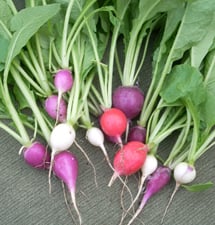
Easter Egg Radish
When to Plant
March 15-Aug. 31
How to Plant
Plant from seed.
Harvesting Tips
Named for their fun variety of colors, the Easter Egg Radish comes in a beautiful mix of red, purple and white round radishes. Radishes can be harvested at most any size, and these in particular maintain a great mild taste and crisp texture if you let them get a bit larger. Pull the plant straight up out of the ground so as not to disturb surrounding radishes that are not quite ready.
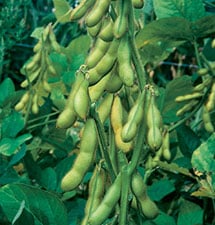
Edamame
When to Plant
April 15-June 15
How to Plant
Plant from seed. Direct seed about 1 inch deep and about 1.5 inches apart. Coat the seeds with a soybean inoculant mixed with water prior to planting. This will help the seeds get a better start.
Harvesting Tips
Edamame matures in 75-90 days. Pay attention to how plump the pods are. As soon as they are slightly plump, open up one and look inside. If the beans look at all ripe, start eating. Edamame is ripe when the seed inside the pod is bright green and tastes sweet. Harvest and eat frequently for the next two to three weeks.
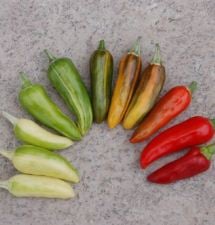
Fish Pepper
When to Plant
May 15-July 15
How to Plant
Transplant seedling.
Harvesting Tips
With its hot and spicy flavor, this variety was originally often used in fish and shellfish cooking in the Northeast. Colors range from green, orange, brown, white, and red - sometimes a stripy mix of pigments. The plant also produces beautiful ornamental green/white mottled leaves. Be sure to search for the lighter colored peppers as they can hide in the leaves. Simply pick the peppers by hand when ready. This is a good variety for container growing, and also great for drying into chili powder.
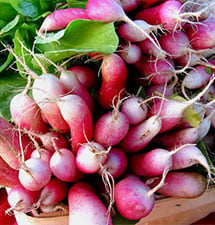
French Breakfast Radish
When to Plant
March 15-Aug. 31
How to Plant
Plant from seed.
Harvesting Tips
You can harvest radishes at almost any size. However, the longer you leave them in the ground, the spicier they become. If you want them for salads, harvest them when they are smaller which is when they are crisper. Pull the plant straight up out of the ground so as not to disturb surrounding radishes that are not quite ready.
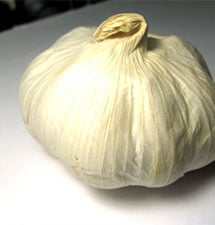
Garlic
When to Plant
Oct. 15-Nov. 25
How to Plant
You can either buy a bulb of seed garlic or certified organic garlic. Break the bulb into its individual cloves and plant the garlic clove with the point facing up and the root (base of the garlic) facing down. Plant the clove 4-6 inches below the soil and 6 inches apart.
Harvesting Tips
If you planted a hard-neck variety, in the early summer, the garlic will shoot up a seed stalk from the middle. These should be cut and can be eaten as delicious garlic "scapes." In mid-summer, around mid-July, garlic can be harvested. You know for certain they are ready when the tops start to turn yellow or brown, or if you poke your finger under the soil line and feel for a bulb about 3 inches in diameter. When the stalks begin to yellow or brown, bend them over to allow them to dry; pull the garlic a couple of weeks later. If you want to store garlic through the winter, clean it off and dry it for a couple weeks in a cool, dry area with good air circulation; stalks can be braided and hung.
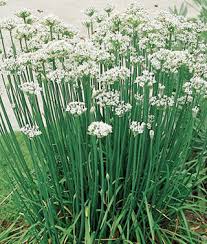
Garlic chives
When to Plant
April-May after last frost
How to Plant
Garlic chives are typically grown from transplants. They grow to be quite large and take up about one square foot in the garden.
Harvesting Tips
Be sure to cut the leaves down to the base when harvesting (within 1 to 2 inches of the soil). After the flowers bloom, be sure to remove them so that the seeds aren't spread throughout your garden.

Gem Marigold
When to Plant
April-May
How to Plant
Grow them in full sun in soil that drains well. Keep plants consistently watered but not drenched.
Harvesting Tips
Deadhead the blossoms to encourage additional blooming. Marigolds self-sow and will often repopulate an area of the garden in successive seasons, lending their brilliant gold hues and providing you with a steady profusion of blooms.
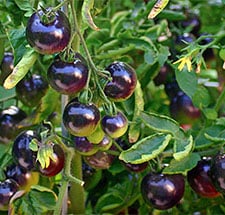
Gold Berry Tomato
When to Plant
May 15-July 15
How to Plant
Transplant seedling.
Harvesting Tips
This is a cherry type of tomato in bright purple and yellow colors, gathering in long clusters with small fruits. The gold berry has a sweet and rich flavor, and the plants are productive and sturdy. This tomato benefits from growing in a cage—gently direct stems to grow vertically, allowing the plant to grow as tall as possible while remaining contained in the cage. Judge ripeness by two factors: bright yellow color with indigo-purple shoulders and a slightly soft feel that gives a little when touched. Prune minimally, if any, as this can spread disease. Some years, if your fruit is ripening slowly (approximately mid-August), give the plant a haircut by removing the topmost central branch, and remove excess foliage to expose the fruit to more sunlight.
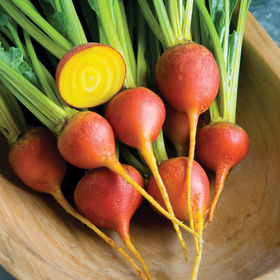
Golden Beets
When to Plant
March 15-May 30 or July 15-August 31
How to Plant
Plant from seed.
Harvesting Tips
Apart from the root of the beets, the leaves can also be used similarly to chard – eat raw, cooked, or juiced. Harvesting beets depends on the size you prefer to consume. Beets start to become harvestable when their tops protrude above the soil. The best beets tend to be darker in color with smooth skin. If you wait too long, they can become fibrous or soft and squishy. For beet greens, harvest starting around five weeks, or when leaves are about 3 inches tall.
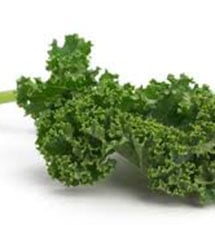
Green Curly Kale
When to Plant
March 15-Aug. 1. Kale can be planted throughout the season, but the later in the season, the less likely you will be able to harvest full-grown leaves. The last date you can plant kale as a transplant for full-grown plants would be around Aug. 1, earlier being better.
How to Plant
Plant from seed or transplant seedling.
Harvesting Tips
Thin aggressively. Thin to 8-12 inches apart. Harvest the leaves from the bottom up and tidy the plant as you go. If there are old, yellowed leaves at the base, remove and discard them. Cut leaves at the stem/base. Do not take all the leaves off, so it will continue to regenerate.
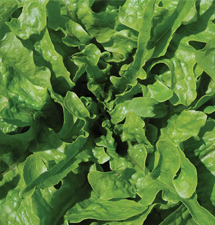
Green Oakleaf Lettuce
When to Plant
March 15-Aug. 31
How to Plant
Plant from seed or transplant seedling.
Harvesting Tips
If started from seedling, it’s ready in 2-3 weeks; if started from seed, it’s ready in 30-45 days. There are two ways to approach harvest: If growing for a head of lettuce, thin 8 inches apart, eat outer leaves until it’s getting vertical height then pull it out. Or use the “cut and come again” method. Do not thin. Cut with scissors. Harvesting can begin when lettuce is 3-4 inches tall. Once it starts to taste bitter, pull it out. If harvesting lettuce when hot, “hydrocool” it – let lettuce sit in a sink full of cold water for 5-10 minutes, then spin in salad spinner and eat, or store in well sealed storage container or Ziploc bag (air-tight storage is key).
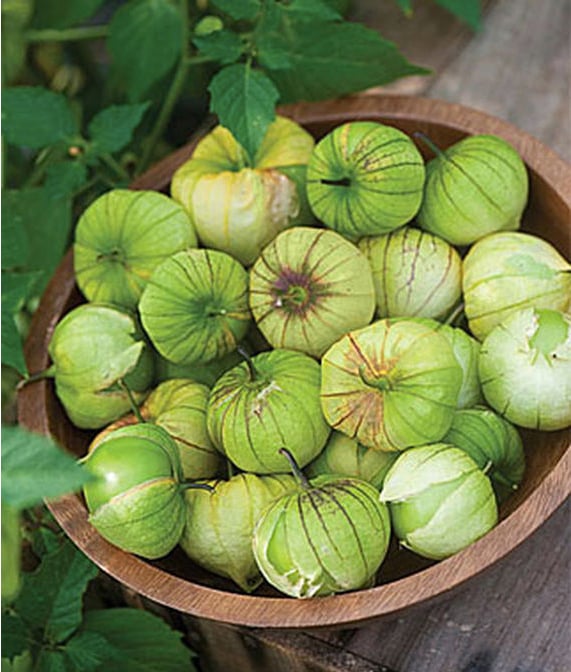
Green Tomatillo
When to Plant
May 15-July 15
How to Plant
Plant from transplant seedlings. If you’re able, grow tomatillos in a cage to allow them to grow as tall as possible - gently direct the stems to grow vertically within the space. Tomatillos need to be planted in pairs to ensure fruiting.
Harvesting Tips
Tomatillo harvesting is best when the fruits are green because they contain the most flavor. It’s important to know how to harvest tomatillos to enhance continued fruiting. Choose fruits that have burst their husk and have no signs of disease, mold or insect damage. Remove and compost any damaged fruits. Cut the fruits off the plant to avoid harming the stems and other fruit.
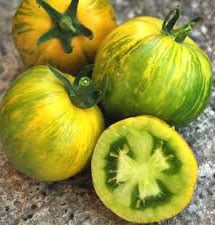
Green Zebra Tomato
When to Plant
May 15-June 15
How to Plant
Transplant seedling.
Harvesting Tips
Keep an eye on them. If pests such as squirrels or chipmunks are munching on them, harvest on the early side of ripe and place tomatoes in a window sill to finish ripening. Judge ripeness by color and touch. Is the tomato the color it’s supposed to be? When you gently press into the skin, does it give a little and feel somewhat soft? Keep pruning to a minimum if at all as this can spread disease. If fruit is ripening slowly, remove excess foliage to expose the fruit to more sunlight.
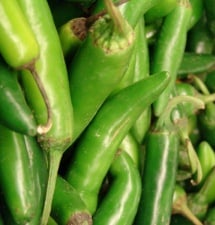
Habanero/Serrano Pepper
When to Plant
May 15-July 15
How to Plant
Transplant seedling.
Harvesting Tips
These peppers are sweet from the start, and they will be sweetest when harvested at their deepest red color. Simply pick by hand when ready. The Carmen is an Italian variety, and works best roasted or fried. This pepper is very adaptable and disease resistant, and a fine candidate for containers or indoor planting.
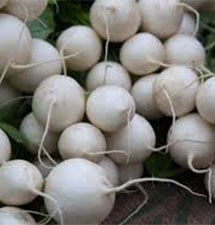
Hakurei Turnip
When to Plant
March 15- Aug. 31
How to Plant
Plant from seed.
Harvesting Tips
If you harvest turnips when small, they will have a milder, sweeter taste. When they are exposed to mild frost they also become sweeter, but you have to pull them before a heavy freeze or the root may crack and rot in the soil. Pull as soon as roots mature. Turnips that are ready will poke out of the soil level a bit just at the top of the root when they are ready. The best thing to do would be to pick one to evaluate the size. After harvesting the turnip root, cut the greens off and store in a cool spot.
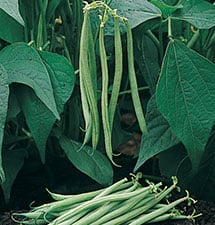
Haricot Vert - French Filet Beans
When to Plant
May 15-June 30
How to Plant
Plant from seed. Direct seed about 1.5 inches deep and about 2-3 inches apart. Coat the seeds with a bean/pea inoculant mixed with water prior to planting. This will help the seeds get a better start.
Harvesting Tips
Start harvesting when beans are young and tender, around 3-4 inches. Harvest frequently to ensure the plant produces more. Look closely while harvesting as beans may be hiding from view. Keep harvesting even if you are not eating the beans so they keep producing.
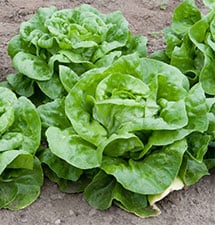
Head Lettuce
When to Plant
March 17- Aug. 31
How to Plant
Plant from seed or transplant seedling.
Harvesting Tips
Do not wait too long to harvest – this is a rookie move! Young lettuce is very tender and sweet. It grows quickly. If started from plant, it’s ready in 2-3 weeks; if started from seed, it’s ready in 30-45 days.
There are two ways to approach harvest: If growing for a head of lettuce, thin 8 inches apart, eat outer leaves until it’s getting vertical height then pull it out. Or use the “cut and come again” method. Do not thin. Cut with scissors. Harvesting can begin when lettuce is 3-4 inches tall. Once it starts to taste bitter, pull it out.
If harvesting lettuce when hot, “hydrocool” it – let lettuce sit in a sink full of cold water for 5-10 minutes, then spin in salad spinner and eat, or store in well sealed storage container or Ziploc bag (air-tight storage is key).

Italian Pole Bean
When to Plant
May 15-July 15
How to Plant
Pole beans need well drained soil and plenty of organic amendment to produce a large crop. Full sun situations are preferable in temperatures that are at least 60 degrees Farenheit. Pole beans need a support structure at least 5 feet high and the vines can grow 5 to 10 feet long. They need at least an inch of water per week and should not be allowed to dry out, but also can tolerate soggy soils. Pole beans need a little help climbing their support structure, especially when young.
Harvesting Tips
Harvest beans as soon as the pods are full and swollen. Beans should be picked every three to five days to avoid harvesting older beans which can be woody and bitter. Consistent harvesting will encourage new flowers and promote longer living vines.
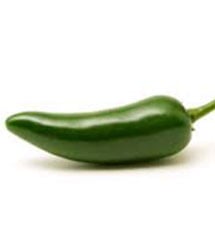
Jalapeño Pepper
When to Plant
May 15-June 15
How to Plant
Transplant seedling.
Harvesting Tips
Be patient. Peppers need lots of sun and time to change color. If you want green jalapeño peppers, harvest when green. The color change is what really takes time. They are heat-loving plants and will likely be ready for harvest in September or October.
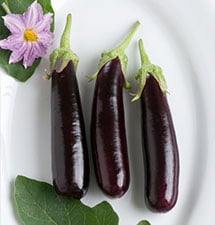
Japanese Eggplant
When to Plant
May 15-June 30
How to Plant
Transplant seedling.
Harvesting Tips
Harvest 60-80 days after planting. Cut the stem with a knife or pruners to harvest. If the eggplant is touching the ground, harvest as soon as it seems ready – before bugs or critters get to them.

Kale Vates (Green Curly)
When to Plant
For an early spring harvest, continuing into summer, seed kale by Sept. 20
How to Plant
Plant from seed. Direct seed about 1/2 inch to 1 inch deep, about 6-8 inches apart.
Harvesting Tips
Kale planted late in summer or early fall will yield an early crop of kale as soon as you can open your season extension. Harvest lightly, 3-4 leaves at a time, until the cover can be removed when temperatures are consistently above freezing. Do not take all of the leaves off, so it will continue to regenerate.
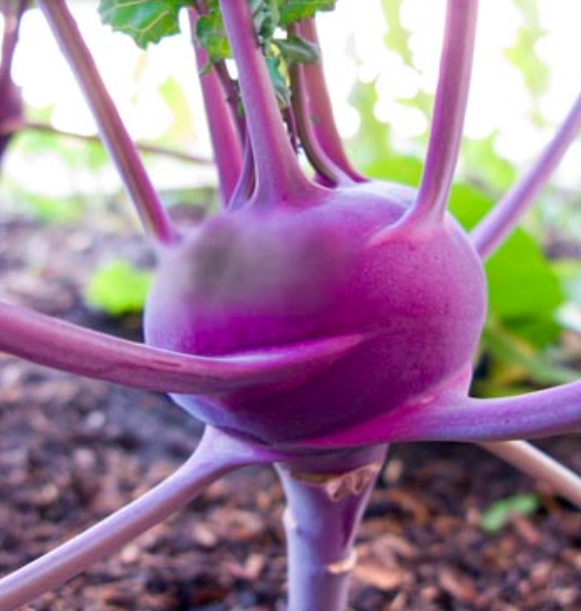
Kohlrabi
When to Plant
Best grown in cooler weather.
How to Plant
Sow seeds outdoors as soon as soil can be worked and danger of hard frost has passed. Can also be started indoors and transplanted out. Plant in full sun or partial shade.
Harvesting Tips
Harvest kohlrabi plants when the bulbs reach 3 inches in diameter. Cut the stem just above the soil line.
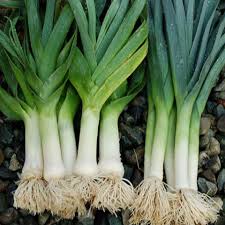
Leeks
When to Plant
As soon a risk of a hard frost has passed.
How to Plant
Leeks are usually sown in pots or trays of potting soil and then transplanted into their final position when they’re big enough. Begin by ‘dibbing’ (poking) holes that are about the same height as the leek seedlings' stems into well-dug soil. Make one hole for each plant. The holes should be about six inches apart, with a foot left between rows, or if you’re planting in blocks space them seven inches apart each way. Now carefully remove the leeks from their pots and tease the roots apart. Place the seedlings into the holes. It’s important that the roots reach right down to the bottom of the hole, so if necessary, help them along – you may need to trim them to get them in if they’re very long.
Harvesting Tips
Harvest as soon as they look ready or wait until the first snow. Slip a fork underneath the plant to lever it out, while pulling up on the leaves. Trim the roots and any damaged leaves and wash away the soil. Hardy varieties may be dug up as needed over the winter, though in very cold areas you may want to dig them up before the ground freezes solid.
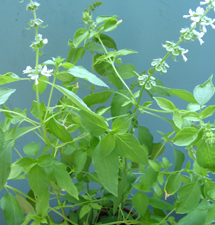
Lemon Basil
When to Plant
May 15-July 15
How to Plant
Plant from transplant seedling or direct seed.
Harvesting Tips
A silvery-green plant with lemony aroma and flavor. Taking care to harvest your herb will ensure that it continues to produce and look attractive. Begin using the leaves as soon as the plant is large enough to spare some. To harvest, cut a handful of the basil and leave at least a third of the stem so that it continues to produce. Unless you are growing the basil as an ornamental, cut or pinch off the flowers so that the plant can focus its energy on the leaves. This basil is a nice addition to sweet and savory recipes that already contain lemon flavors - don’t replace lemons with the basil, rather add it to enhance the lemon flavor. Try crushing it up and adding it into lemonade! Great candidate for container growing - planting this variety in containers around your patio or outdoor space will help repel mosquitos and flies.
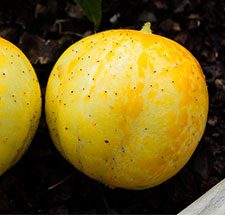
Lemon Cucumber
When to Plant
May 15-July 15
How to Plant
Plant from seed or transplant seedling. Cucumbers are very sensitive to cold, so it is important to make sure that both the soil and air have fully warmed before planting. Thin and leave the healthiest, largest 1-2 seedlings in the ground (usually 3-4 were planted to start). Cucumbers like to climb—help them attach to a fence, trellis, or cage with loose ties or plant Velcro.
Harvesting Tips
The lemon cucumber is sweet and versatile, often served raw but also a great pickling cucumber. They may be harvested young or can wait. They are delicious at any time. This variety is late to begin bearing fruit.
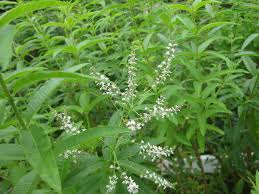
Lemon Verbena
When to Plant
After last frost around May 15
How to Plant
Lemon verbena prefers full sun and free-draining soil that has been amended with compost. Heavy clay or overly wet soils will cause the roots to rot. Plant crop near the edge of the bed where you'll be apt to brush by the foilage, causing the leaves to release some of their lemony scent.
Harvesting Tips
Cut back individual stems to within 1/4 inch of a leaf or leaf node. Remove no more than one quarter of the stem at each harvest. Allow the rest of the plant to continue growing. Lemon verbena will quickly produce new foilage after a full harvest. Harvesting also encourages further branching and a fuller plant.
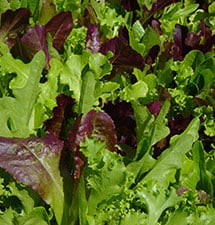
Lettuce (Cold Mix)
When to Plant
For a late fall harvest, seed by Sept. 20.
How to Plant
Plant from seed. Direct seed about 1/2 inch to 1 inch deep, with about 20 seeds per foot.
Harvesting Tips
Because of the slow growth period of late fall and early winter, do not expect large heads. Winter lettuce is best grown as a baby lettuce mix. Cut with scissors or a sharp knife once there are 6-8 leaves per plant. Be sure to re-cover the plants after harvesting or checking on your late season crops.
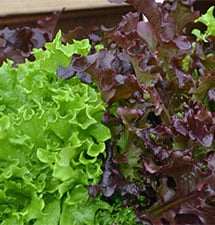
Lettuce Mix
When to Plant
March 15-Aug. 31
How to Plant
Plant from seed.
Harvesting Tips
When leaves are about 3-4 inches high, you can harvest using the "cut and come again" method. Using a knife, cut about an inch from the ground, allowing the small center leaves to remain to grow into the next round of lettuce. Using this method, you will generally be able to get 2-3 harvests before the lettuce becomes tough and bitter. Use hydrocooling when harvesting in warm weather.
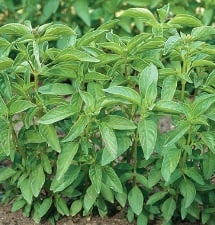
Lime Basil
When to Plant
May 15-July 15
How to Plant
Plant from transplant seedling or direct seed.
Harvesting Tips
Similar to lemon basil, the lime variety has a mild citrus taste and bright lime scent. A great addition to sauces, salad dressings or salsas. Taking care to harvest your herb will ensure that it continues to produce and look attractive. Begin using the leaves as soon as the plant is large enough to spare some. To harvest, cut a handful of the basil and leave at least a third of the stem so that it continues to produce. Unless you are growing the basil as an ornamental, cut or pinch off the flowers so that the plant can focus its energy on the leaves. This is a great candidate for container growing.
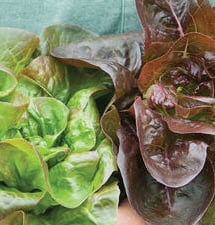
Little Gem Lettuce
When to Plant
March 15-Aug. 31
How to Plant
Plant from seed or transplant seedling.
Harvesting Tips
If started from seedling, it’s ready in 2-3 weeks; if started from seed, it’s ready in 30-45 days. There are two ways to approach harvest: If growing for a head of lettuce, thin 8 inches apart, eat outer leaves until it’s getting vertical height then pull it out. Or use the “cut and come again” method. Do not thin. Cut with scissors. Harvesting can begin when lettuce is 3-4 inches tall. Once it starts to taste bitter, pull it out. If harvesting lettuce when hot, “hydrocool” it – let lettuce sit in a sink full of cold water for 5-10 minutes, then spin in salad spinner and eat, or store in well sealed storage container or Ziploc bag (air-tight storage is key).
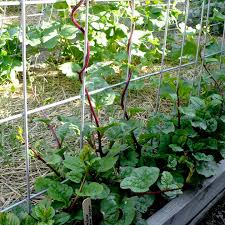
Malabar Spinach
When to Plant
July 15-Aug. 31
How to Plant
Malabar spinach prefers full sun exposure but can also be grown in partial shade. It is a vine that grows aggressively and requires a tall support (at least 4-6 feet).
Harvesting Tips
Pinch spinach leaves. Use malabar spinach just like regular spinach greens. In India, it is cooked with spicy chilies, chopped onion and mustard oil. It is also found frequently in soups, stir-frys and curries.
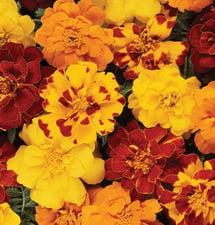
Marigold
When to Plant
May 1-August 15
How to Plant
Plant from seed or transplant seedling.
Harvesting Tips
Bright orange, gold, and red flowers add accent color to the garden. We grow marigolds as companion plants not just for beauty, but to attract beneficial pollinators for the entire garden.
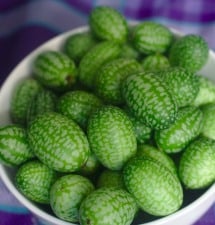
Mexican Sour Gherkin
When to Plant
May 15-July 15
How to Plant
Plant either from direct seed or transplant seedling. Cucumbers are very sensitive to cold, so it is important to make sure that both the soil and air have fully warmed before planting.
Harvesting Tips
These unique cucumber-like fruits look like baby watermelons and have a sweet-and-sour cucumber taste. They’re a tiny variety and will grow to just 1 to 2 inches. Thin the plant and leave the healthiest, largest seedling in the ground (usually 3 to 4 seeds are planted to start if using direct seed). Cucumbers like to climb. Attach them to a fence, trellis, or cage with loose ties, but this variety does have a pleasing mounding habit. Once you harvest your first cucumber, look for new fruit daily. This variety also produces a nice ornamental flower on its climbing vines. Great for pickling or to toss into a salad. This is a very fun variety to plant with kids.
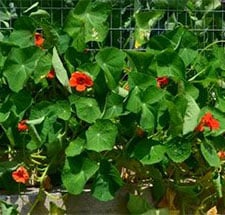
Nasturtium
When to Plant
May 15-July 15
How to Plant
Plant from seed or transplant seedling.
Harvesting Tips
Nasturtiums are easy to grow annuals with edible leaves, and they are great for growing with children. These crops feature bright greenery and red, orange, and yellow flowers. They are great as a cut flower. Cutting the faded or dead flowers throughout the season will help to keep the plant productive. If growing in containers, you may need to trim them back throughout the season. Do not over water.
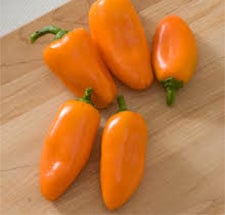
Orange Lunchbox Sweet Pepper
When to Plant
May 15-July 15
How to Plant
Transplant seedling.
Harvesting Tips
Be patient. In order for the peppers to change color, they need lots of sun. When you’re ready to eat, as indicated by the full color change, snip the peppers off at the stem and enjoy. These are best eaten raw as snacking peppers.

Oregano
When to Plant
May 15-July 15
How to Plant
Plant from seed.
Harvesting Tips
A great companion plant to most vegetables in the garden. Trim regularly once the plant has reached 4 inches. Harvest leaves as needed - they store well and can be dried. Oregano is a classic flavor in Italian cooking - add to homemade pizza or pasta sauce.
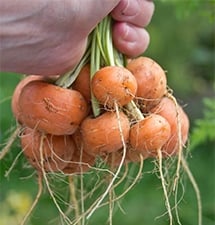
Paris Market Carrots
When to Plant
March 15-July 15
How to Plant
Plant from seed about 1/2 inch deep and about 1 inch apart.
Harvesting Tips
This French heirloom variety is short, stout and round in a classic orange color. Its short roots make it a great candidate for container gardening. Carrots generally take 65-75 days to mature, depending on the time of year and weather conditions. Thin the carrots when the carrot tops are 2 inches high, leaving 2-3 fingers’ width (approximately 1.5-2 inches) between each plant. Carrots are sweetest when harvested in cold weather because the sugars become condensed. Time your planting so that you’ll be harvesting in fall or early winter. For example, plant carrots with a 90-day maturity cycle in early July to harvest in October.
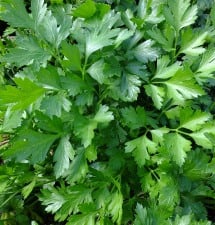
Parsley
When to Plant
May 15-July 15
How to Plant
Transplant seedling.
Harvesting Tips
Begin to harvest parsley as soon as the plant is growing strongly. Cut individual outer stems toward the base to ensure the plant will continue producing. Parsley is great for drying and freezing, a classic flavor used in savory dishes or as garnish. This is a great candidate for container growing.
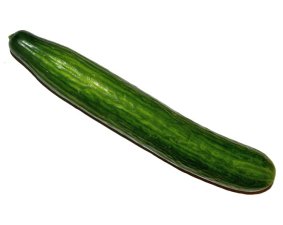
Persian Cucumber
When to Plant
May 15-July 15
How to Plant
Plant either from direct seed or transplant seedling. Cucumbers are very sensitive to cold, so it is important to make sure that both the soil and air have fully warmed before planting.
Harvesting Tips
Sweet flavor and smooth, delicate skins. Thin the plant and leave the healthiest, largest seedling in the ground (usually 3 to 4 seeds are planted to start if using direct seed). Cucumbers like to climb. Attach them to a fence, trellis or cage with loose ties. The fruit is well camouflaged. Look closely as it can hide from you! This variety is at peak sweetness at 4 to 6 inches in length. Once you harvest your first cucumber, look for new fruit daily. Though this variety is considered “seedless,” light undeveloped seeds are inevitable. The seeds growing within the cucumber tend to get larger the longer the fruit stays on the vine, so keep in mind for your texture preference.
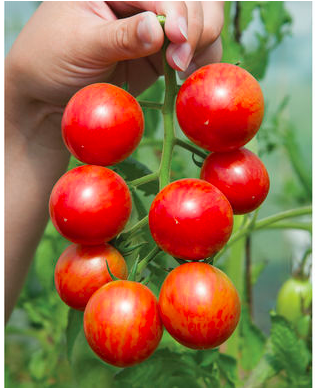
Pink Bumble Bee Tomato
When to Plant
May 15-July 15
How to Plant
Transplant seedling.
Harvesting Tips
Keep an eye on them. If pests such as squirrels or chipmunks are munching on them, harvest on the early side of ripe and place tomatoes in a window sill to finish ripening. Judge ripeness by color (deep yellow with unique red and pink marbling) and touch. Is the tomato the color it’s supposed to be? When you gently press into the skin, does it give a little and feel somewhat soft? Keep pruning to a minimum if at all as this can spread disease. If fruit is ripening slowly, remove excess foliage to expose the fruit to more sunlight.
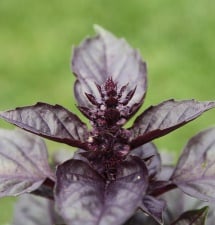
Purple Basil
When to Plant
May 15-July 15
How to Plant
Plant from transplant seedling or direct seed.
Harvesting Tips
This variety is true to its name its with deep purple leaves and stem. It has a slightly spicy flavor with hints of clove. Taking care to harvest your herb will ensure that it continues to produce and look attractive. Begin using the leaves as soon as the plant is large enough to spare some. To harvest, cut a handful of the basil and leave at least a third of the stem so that it continues to produce. Unless you are growing the basil as an ornamental, cut or pinch off the flowers so that the plant can focus its energy on the leaves. Use in salads, oils and dressings. This is a great candidate for container growing.
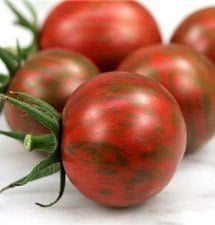
Purple Bumblebee Tomato
When to Plant
May 15-July 15
How to Plant
Transplant seedling. If you’re able, grow tomatoes in a cage to allow them to grow as tall as possible. Gently direct the stems to grow vertically within the space
Harvesting Tips
A deep red cherry tomato with unique green-bronze striping. Their complex sweet flavor makes them great for snacking. Prune minimally (if at all) as this can actually spread disease. If your fruit is ripening slowly (approximately mid-August in Chicago), give the plant a haircut by removing the topmost central branch, and remove excess foliage to expose the fruit to more sunlight. You’ll know it’s ready for harvest when the fruit gives a little when squeezed, and when it’s at its peak color. Store at room temperature rather than in the fridge.
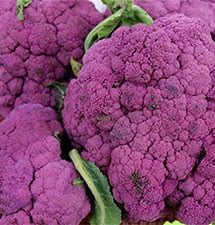
Purple Cauliflower
When to Plant
March 15- May 30. For a fall harvest, plant by July 15.
How to Plant
Plant from seed or transplant seedling.
Harvesting Tips
As cauliflower grows, try to protect it from the light by tucking some of the surrounding leaves over the head or fastening them loosely together. A mature head should be firm and compact. Cut the head from the main stem, but try to leave a few leaves covering the head to prolong the fresh quality.
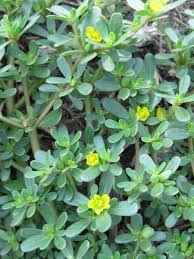
Purslane
When to Plant
May-August
How to Plant
The plants aren't picky about soil type or nutrition, but purslane does tend to grow better in dried soil. If you decide to plant purslane seeds, simply scatter where you plan on growing them. Don't cover the seeds with soil. Purslane seeds need light to germinate so they must stay on the surface of the soil. If you are using cuttings, lay them on the ground where you plan on growing them. Water the stems and the purslane should take root in a few days.
Harvesting Tips
Make sure to harvest regularly and be aware that it can become invasive. Harvesting before it develops flowers will help cut down on its spread.
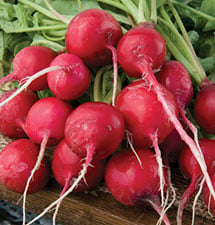
Radish (Red)
When to Plant
March 15-May 30, or Aug. 15-Sept. 1. Radishes are best planted for harvest during cooler weather; the hotter the weather, the hotter the taste. Jeanne Nolan seeds radish from early April until late May, but you may be able to get a fall harvest with a late summer sowing.
How to Plant
Plant from seed. Direct seeds about 1/2 inch deep about 1 inch apart.
Harvesting Tips
Thin so plants are 2 inches apart. Do not wait too long to harvest. Harvest when young, approximately 1-2 inches in diameter. Pull one at three weeks and keep an eye on them as radishes mature quickly. Pull as soon as roots mature. Radishes that are ready will poke out of the soil level a bit just at the top of the root when they are ready. The best thing to do would be to pick one to evaluate the size.
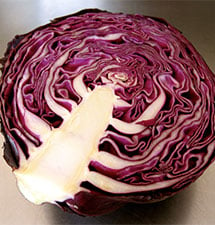
Red Cabbage
When to Plant
March 15-May 30
How to Plant
Transplant seedling
Harvesting Tips
Solid heads indicate when it is time for harvesting cabbage. If you squeeze the head and it’s firm all the way through, then the cabbage is ready for harvest. Cut at the lowest point below the head as possible, leaving the loose outer leaves attached to the stalk. Sometimes this will allow for a later cabbage harvest of sprouts, which will grow on the stem after the cabbage head is removed. Try to harvest before abundant rainfall because cabbage heads are susceptible to becoming waterlogged.
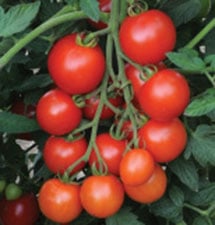
Red Cherry Tomato
When to Plant
May 15-June 15
How to Plant
Transplant seedling.
Harvesting Tips
Keep an eye on them. If pests such as squirrels or chipmunks are munching on them, harvest on the early side of ripe and place tomatoes in a window sill to finish ripening. Judge ripeness by color and touch. Is the tomato the color it’s supposed to be? When you gently press into the skin, does it give a little and feel somewhat soft? Keep pruning to a minimum if at all as this can spread disease. If fruit is ripening slowly, remove excess foliage to expose the fruit to more sunlight.
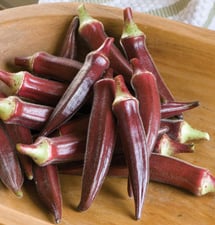
Red Okra
When to Plant
May 15-July 15
How to Plant
Plant from seed or transplant seedling.
Harvesting Tips
Begin harvesting when pods are 2 inches long. Check daily. They grow very rapidly and are very tender at between 2 and 3.5 inches but will become tougher as they get larger. Tasty simply sauteed with olive oil and garlic. The beautiful flowers are also edible with a sweet, mild flavor. Try using them as a garnish.
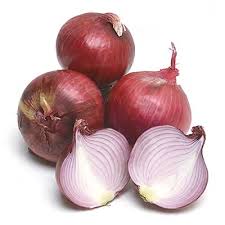
Red onion
When to Plant
Late March through early April.
How to Plant
Most gardeners plant onion sets, the second year small red onion bulbs, to hasten the maturation and harvest of the onions. All onions need plenty of sun and well-draining soil. Set the onion bulbs 1-2 inches deep so the roots are well covered but the neck isn’t set too deeply. Space the plants 6 inches apart in furrows 12 inches apart. Water the onions until they are wet, but not drenched. You can lay a light layer of grass clippings or other fine mulch around the onions, but be sure to keep it away from the onion tops which need full access to the sun.
Harvesting Tips
You can pull onions after a few weeks if you just want to use them as scallions, but for full-size onions, you must be patient and let them mature. Onions are ready to harvest when the bulbs are large and the green tops begin to yellow and fall over. Stop watering the onion when around 10% of the tops begin to fall over. You can now harvest the onions or leave them in the ground to be stored and used as needed. To harvest the onions, dig the onions up and shake off the loose soil. Lay them out to cure with the tops still attached, in a warm, airy place. Keep the onions dry with good air circulation so they don’t rot. As the onions cure, the roots shrivel and the necks dry out. Allow the onions to cure for seven to 10 days and then either braid the tops for storage or remove the tops and roots with pruning shears. Store the cured onions in a cool, dry place between 35-50 degrees Fahrenheit.
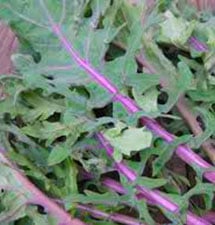
Red Russian Kale
When to Plant
March 15- Aug. 1
How to Plant
Plant from seed or transplant seedling.
Harvesting Tips
Thin aggressively to 8-12 inches apart. Harvest the leaves from the bottom up and tidy the plant as you go. Remove and discard of any old, yellowed leaves at the base. Cut leaves at the base. Do not take all of the leaves off at once. This ensures that the plant will continue to regenerate throughout the season.

Red Yard Long Bean
When to Plant
May 15-July 15
How to Plant
Plant from seed.
Harvesting Tips
The yard long bean is true to its name, with pods ranging from 14 to 30 inches at their peak - sometimes called a “noodle bean” for its length. A traditional Asian crop, these beans can grow very quickly in warm climates. Start harvesting when young and tender, around 3-4”. Harvest frequently to ensure that the plant continues to produce more - even if you’re not going to eat all of them, make sure to keep picking. Look closely as the beans may be hiding from you! No thinning required. In fact, you may even have to tie the plant back. Feel free to cut the bean into shorter pieces for cooking and treat as you would a normal green bean. The burgundy color will fade when cooked.
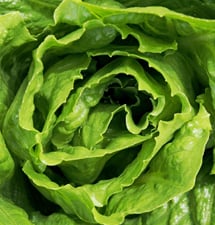
Romaine Lettuce
When to Plant
March 15-Aug. 31
How to Plant
Plant from seed or transplant seedling.
Harvesting Tips
When leaves are about 3-4 inches high, you can harvest using the "cut and come again" method. Using a knife, cut about an inch from the ground, allowing the small center leaves to remain to grow into the next round of lettuce. Using this method, you will generally be able to get 2-3 harvests before the lettuce becomes tough and bitter. Use hydrocooling when harvesting in warm weather.
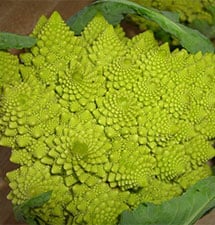
Romanesco Cauliflower
When to Plant
March 15-May 30. For a fall harvest, plant by July 15.
How to Plant
Plant from seed or transplant seedling.
Harvesting Tips
Like cauliflower and broccoli, a mature head should be firm and compact. Cut the head from the main stem, but try to leave a few leaves covering the head to prolong the fresh quality.
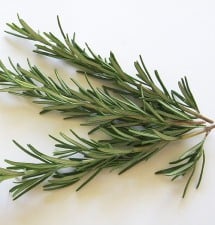
Rosemary
When to Plant
May 15-July 15
How to Plant
Transplant seedling.
Harvesting Tips
Another classic herb, rosemary is a woody-stemmed plant with needle-like leaves. You can cut the stems at any time and use the herb fresh. Also try hanging bunches of the stems upside down to dry, then strip the leaves off of the stems to use as a dried herb. Perfect baked into breads, added into oils or even included in wreaths and bouquets. This is a great candidate for container gardening.
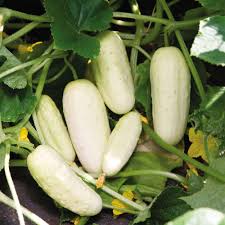
Salt and Pepper Cucubmer
When to Plant
May 15-July 15
How to Plant
Try to plant salt and cucumbers in a location that enjoys full sun and remember to water often. Keep in mind that salt and pepper cucumbers are thought of as tender, so it is really important to ensure that outside temperature is well above freezing before planting.
Harvesting Tips
Once fruit bearing begins, pick daily. They are delicious when harvested young.
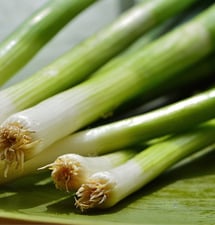
Scallion
When to Plant
March 15-Aug. 30
How to Plant
Plant from seed or transplant seedling.
Harvesting Tips
Harvest when the height is approximately 8-12 inches (or when they look like what you’re used to eating from the store). Pull out the entire thing. Eat roots and all.
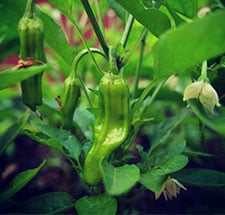
Shishito Hot Pepper
When to Plant
May 15-July 15
How to Plant
Plant seedlings purchased from a nursery or started indoors from 8 weeks before the average last frost (which is usually May 15 in Chicago). Plant after the danger of frost has passed (usually after Memorial Day in Chicago). Make a planting hole twice as large as the container the seedling is in. Remove from pot, open the roots with your fingers, and place in the planting hole. Plant deeply—up to the first set of leaves—and tuck the soil back around the plant stem. Water root area well, and keep moist during the first 5-10 days after transplanting.
Harvesting Tips
A small, mild Japanese pepper. Great for roasting, pan-frying, and grilling – the pepper’s thin walls take on great flavor when cooking in heat. Typically harvested and eaten while green, but over time the pepper will turn orange with a sweeter flavor.
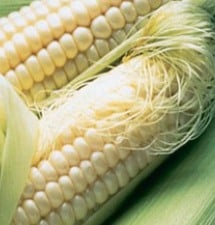
Silver Queen Corn
When to Plant
May 15-July 15
How to Plant
Plant from direct seed.
Harvesting Tips
Growing corn requires full sun and some space. Grow in at least a 5-square-foot patch. You must thin diligently, allowing 12” between each plant. When the corn is approximately 1.5 feet tal, mound the earth (create a small hill) up onto the stalk to help it stay erect. It is a shallow rooted crop and can easily blow over without mounding. This variety takes 92 days to mature and should reach about 5 feet tall. Pay attention to the silks. When corn is ready to be harvested, the silks start to look a little brown and dry. The ear should also have a little give when you squeeze it. The final test is to pull back part of the husk and pierce a kernel with a thumbnail. If milky liquid spurts out, the corn is ready to be eaten immediately. The silver queen variety produces nice big ears, with tender white kernels and a classic sweet flavor.
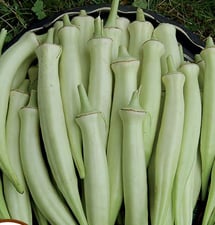
Silver Queen Okra
When to Plant
May 15-July 15
How to Plant
Plant from seed or transplant seedling.
Harvesting Tips
Begin harvesting when pods are 2 inches long. Check daily. They grow very rapidly and are very tender at between 2 and 3.5 inches but will become tougher as they get larger. Tasty simply sauteed with olive oil and garlic. The beautiful flowers are also edible with a sweet, mild flavor. Try using them as a garnish.
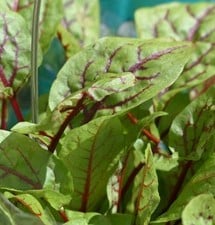
Sorrel
When to Plant
May 15-July 15
How to Plant
Plant from transplant seedling or direct seed.
Harvesting Tips
Sorrel is a unique cold-hardy perennial green with tart, citrusy flavor. Great added into a salad of other raw greens. Harvest leaves when they are young and tender, keeping at least one third of the plant remaining to ensure continuous growth. Remove any flowers before they mature so that the plant can focus all energy on the leaves. This is a great candidate for container growing.
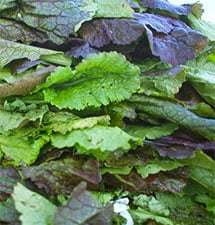
Spicy Greens
When to Plant
March 15-Aug. 31
How to Plant
Plant from seed.
Harvesting Tips
Spicy greens mix is generally ready in 4-5 weeks. When leaves are about 3-4 inches high, you can harvest using the "cut and come again" method. Using a knife, cut about an inch from the ground, allowing the small center leaves to remain to grow into the next round of lettuce. Using this method, you will generally be able to get 2-3 harvests before the lettuce becomes tough and bitter. Use hydrocooling when harvesting in warm weather.
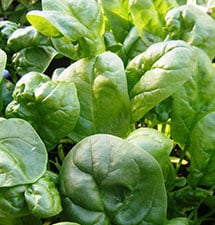
Spinach
When to Plant
May be seeded successfully until Oct. 1
How to Plant
Plant from seed. Direct seed about 1/2 inch to 1 inch deep, about 2-3 inches apart.
Harvesting Tips
Spinach is the classic crop to grow over the winter. It tastes sweeter and becomes especially tender once it is exposed to frost. Harvest any plant that has 6 leaves that are 3-4 inches long. Cut the outside leaves to extend productivity, but limit harvest to outer leaves.
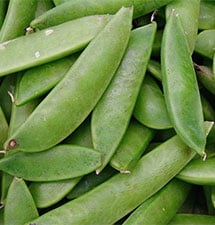
Sugar Snap Peas
When to Plant
March 17- May 30
How to Plant
Plant from seed.
Harvesting Tips
Watch your peas carefully. They become ripe when the pods become swollen. Use two hands when picking peas, one to hold onto the vine, while pulling the pods off with the other. Peas are crisper when picked in the morning. You should continually harvest the pods to encourage more to form.
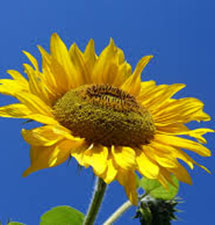
Dwarf Sunflower
When to Plant
April 15-June 15
How to Plant
Plant three seeds in one area, and thin to one plant, spaced 8-12 inches apart.
Harvesting Tips
For harvesting seeds, wait for the sunflower to become brown. The head will be dry to the touch, and the seeds will be plump and black and white striped. The birds and squirrels may eat more of the seeds than the gardener. Once the seeds are ready to eat, rubbing the heads will loosen the seeds.
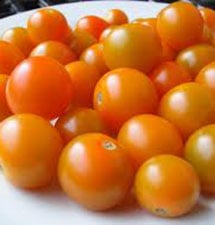
Sungold Tomato
When to Plant
May 15-June 15
How to Plant
Transplant seedling.
Harvesting Tips
Keep an eye on them. If pests such as squirrels or chipmunks are munching on them, harvest on the early side of ripe and place tomatoes in a window sill to finish ripening. Judge ripeness by color and touch. Is the tomato the color it’s supposed to be? When you gently press into the skin, does it give a little and feel somewhat soft? Keep pruning to a minimum if at all as this can spread disease. If fruit is ripening slowly, remove excess foliage to expose the fruit to more sunlight.
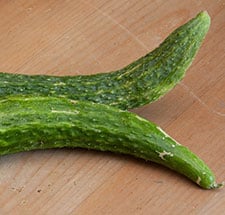
Suyo Long Cucumber
When to Plant
May 15-July 15
How to Plant
Plant from seed or transplant seedling. Cucumbers are very sensitive to cold, so it is important to make sure that both the soil and air have fully warmed before planting. Thin and leave the healthiest, largest 1-2 seedlings in the ground (usually 3-4 were planted to start). Cucumbers like to climb—help them attach to a fence, trellis, or cage with loose ties or plant Velcro.
Harvesting Tips
A ribbed Chinese variety, the Suyo is free of bitter taste and is great fresh or pickled. They may be harvested young or can wait. They’re delicious at any time. The Suyo can grow up to 15 inches long.
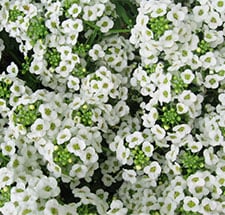
Sweet Alyssum
When to Plant
May 15-July 15
How to Plant
Plant from seed or transplant seedling (which are usually available as a four-pack from a local nursery).
Harvesting Tips
Named for their sweet fragrance, sweet alyssum can act as a lovely border plant, ground cover, or accent in a container. Bees love to visit sweet alyssum’s fragrant white or purple blooms, and the small size flower can attract other beneficial insects. While sweet alyssum can be used as a garnish or used to flavor light-bodied vinegar, we grow alyssum as a companion plant for beauty and to attract beneficial pollinators.
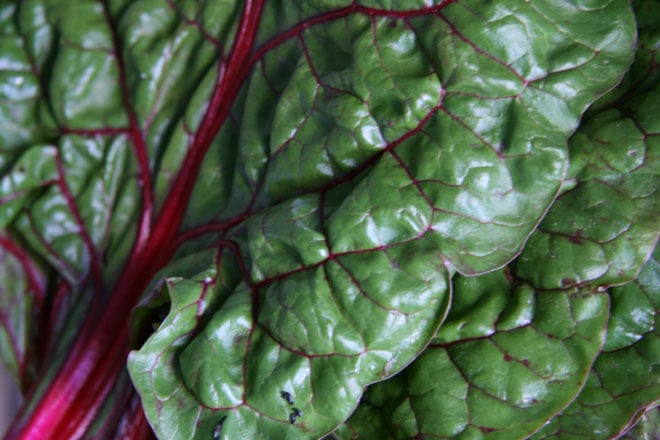
Swiss Chard
When to Plant
March 15-Aug. 31
How to Plant
Plant from seed or transplant seedling.
Harvesting Tips
You can harvest while the leaves are young and tender (smaller than 4 inches) or after maturity. Cut off the outer leaves by snipping close to the base when the leaves are about 8-12 inches long. Always harvest from the outside in, as new growth comes from the center of the plant. For cooking, treat similar to spinach. Swiss chard works well sautéed with garlic or baked into egg dishes.
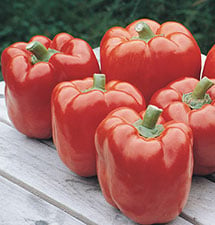
Sweet Bell Pepper (Red)
When to Plant
May 15-June 30
How to Plant
Transplant seedling.
Harvesting Tips
Be patient. Peppers need lots of sun and time to change color. If you want sweet green peppers, harvest when green. The color change is what really takes time. They are heat-loving plants and will likely be ready for harvest in September or October.
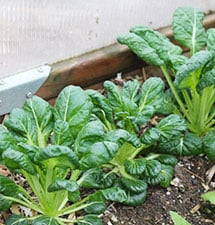
Tatsoi
When to Plant
For a late fall harvest, seed by Aug. 15. For an early spring harvest, seed by Oct. 1.
How to Plant
Plant from seed. Direct seed about 1/2 inch to 1 inch deep, with about 1 inch spacing between seeds.
Harvesting Tips
Because of slower growth during the winter due to cold temperatures and shorter days, plants will be smaller. In the early spring, once the cover can be removed enough to expose the plants, carefully remove the outer leaves for use in salads and stir-frys. Re-cover the plants and leave covered until freezing temperatures have left the area.
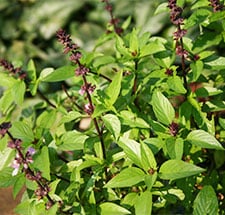
Thai Sweet Basil
When to Plant
May 15-July 15
How to Plant
Transplant seedling.
Harvesting Tips
Thai Sweet basil is an intense, spicy basil flavor with notes of clove and anise. Use it in any recipe that calls for traditional basil. Thai sweet basil, unlike traditional basil, can be left to flower, which intensifies its anise flavor.
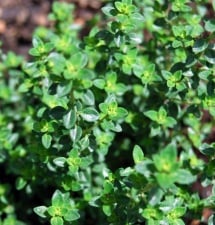
Thyme
When to Plant
May 15-July 15
How to Plant
Transplant seedling.
Harvesting Tips
A lovely herb for both its ornamental quality and savory taste. The green thyme plant also produces small white flowers - you can pinch these off to allow more leaves to produce, but the thyme’s flavor isn’t compromised by letting them bloom. Harvest as needed by clipping, and use a pinching motion with your fingers to strip the leaves from the woody stem before eating. You can easily dry, freeze, or preserve the leaves. This is a great candidate for container growing.
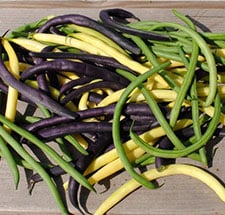
Tri-Color Bush Beans
When to Plant
May 15-July 15
How to Plant
Plant from seed.
Harvesting Tips
Tri-color bush beans are a sturdy mix of yellow, purple, and green beans that are tender, stringless, and juicy with a deep crunch. Start harvesting when young and tender, around 3-4 inches. Harvest frequently to ensure that the plant keeps producing more. Look closely—the yellow and purple pods are easy to spot, but the green pods can blend in with the foliage. No thinning required—you may even have to tie back.
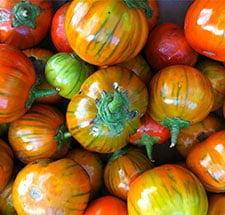
Turkish Orange Eggplant
When to Plant
May 15-July 15
How to Plant
Transplant seedling.
Harvesting Tips
This eggplant is a beautiful heirloom variety from Turkey. It produces about 3-inch round fruits with a sweet and flavorful flesh. Harvest 60-80 days from planting date, when the fruits are green to light orange. Cut the stem with a knife or pruners to harvest. If fruit is touching the ground, harvest as soon as it seems ready—before bugs or critters gets to them.
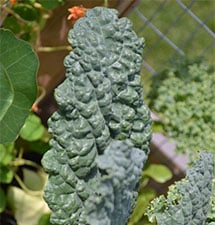
Tuscan/Dino Kale
When to Plant
March 15- Aug. 1
How to Plant
Plant from seed or transplant seedling.
Harvesting Tips
Thin aggressively to 8-12 inches apart. Harvest the leaves from the bottom up and tidy the plant as you go. Remove and discard of any old, yellowed leaves at the base. Cut leaves at the base. Do not take all of the leaves off at once. This ensures that the plant will continue to regenerate throughout the season.

White-Skinned Cucumber
When to Plant
May 15-July 15
How to Plant
Plant either from direct seed or transplant seedling. Cucumbers are very sensitive to cold, so it is important to make sure that both the soil and air have fully warmed before planting.
Harvesting Tips
True to its name, this variety has a pale yellowish-white skin and crisp, clean taste. Thin the plant and leave the healthiest, largest seedling in the ground (usually 3 to 4 seeds are planted to start if using direct seed). Cucumbers like to climb. Attach them to a fence, trellis, or cage with loose ties. The fruit is well camouflaged. Look closely as it can hide from you! Once you harvest your first cucumber, look for new fruit daily. Delicious when harvested young, or you can let it grow. The seeds growing within the cucumber tend to get larger the longer the fruit stays on the vine, so keep in mind for your texture preference. A great variety for pickling.
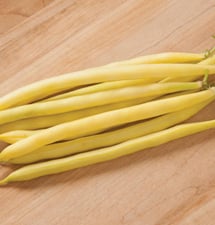
Yellow Wax Bean
When to Plant
May 15-July 15
How to Plant
Plant from seed.
Harvesting Tips
Start harvesting when young and tender, around 3 to 4 inches. Harvest frequently to ensure that the plant continues to produce more - even if you’re not going to eat all of them, make sure to keep picking. No thinning required.
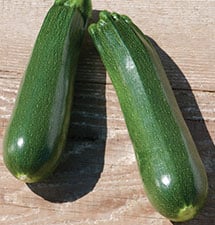
Zucchini
When to Plant
May 15-July 15
How to Plant
Plant three seeds in areas 12 inches apart. Thin to one plant (pick the healthiest plant).
Harvesting Tips
Harvest regularly, every other day; cut zucchini from the plant at the stem with a knife, or use a gentle twisting motion to free the zucchini from the plant. Start harvest when 4 inches long for the most tender zucchini, and harvest up to 8 inches long. Once zucchini gets too large, it is watery and seedy. For blossom harvest, choose the male flowers (which have a long stem and no bulbous bottom to the flower) at midday when open.


